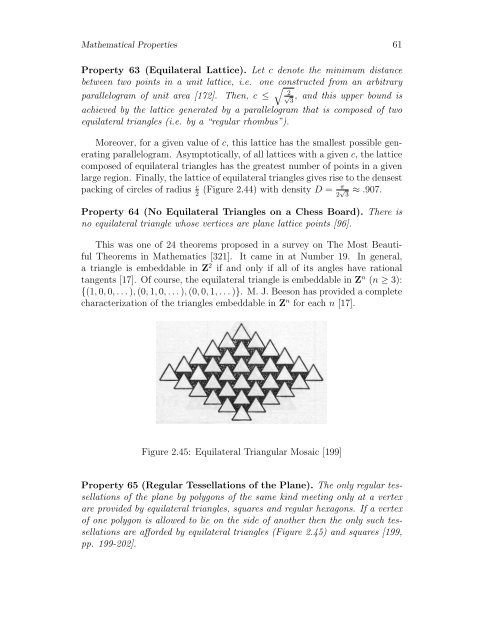MYSTERIES OF THE EQUILATERAL TRIANGLE - HIKARI Ltd
MYSTERIES OF THE EQUILATERAL TRIANGLE - HIKARI Ltd
MYSTERIES OF THE EQUILATERAL TRIANGLE - HIKARI Ltd
You also want an ePaper? Increase the reach of your titles
YUMPU automatically turns print PDFs into web optimized ePapers that Google loves.
Mathematical Properties 61<br />
Property 63 (Equilateral Lattice). Let c denote the minimum distance<br />
between two points in a unit lattice, i.e. one�constructed from an arbitrary<br />
2<br />
parallelogram of unit area [172]. Then, c ≤ √3 , and this upper bound is<br />
achieved by the lattice generated by a parallelogram that is composed of two<br />
equilateral triangles (i.e. by a “regular rhombus”).<br />
Moreover, for a given value of c, this lattice has the smallest possible generating<br />
parallelogram. Asymptotically, of all lattices with a given c, the lattice<br />
composed of equilateral triangles has the greatest number of points in a given<br />
large region. Finally, the lattice of equilateral triangles gives rise to the densest<br />
≈ .907.<br />
packing of circles of radius c<br />
2<br />
(Figure 2.44) with density D = π<br />
2 √ 3<br />
Property 64 (No Equilateral Triangles on a Chess Board). There is<br />
no equilateral triangle whose vertices are plane lattice points [96].<br />
This was one of 24 theorems proposed in a survey on The Most Beautiful<br />
Theorems in Mathematics [321]. It came in at Number 19. In general,<br />
a triangle is embeddable in Z 2 if and only if all of its angles have rational<br />
tangents [17]. Of course, the equilateral triangle is embeddable in Z n (n ≥ 3):<br />
{(1, 0, 0, . . . ), (0, 1, 0, . . . ), (0, 0, 1, . . . )}. M. J. Beeson has provided a complete<br />
characterization of the triangles embeddable in Z n for each n [17].<br />
Figure 2.45: Equilateral Triangular Mosaic [199]<br />
Property 65 (Regular Tessellations of the Plane). The only regular tessellations<br />
of the plane by polygons of the same kind meeting only at a vertex<br />
are provided by equilateral triangles, squares and regular hexagons. If a vertex<br />
of one polygon is allowed to lie on the side of another then the only such tessellations<br />
are afforded by equilateral triangles (Figure 2.45) and squares [199,<br />
pp. 199-202].

















